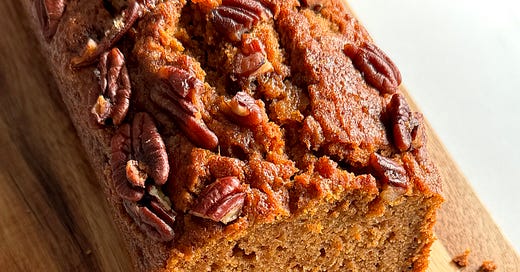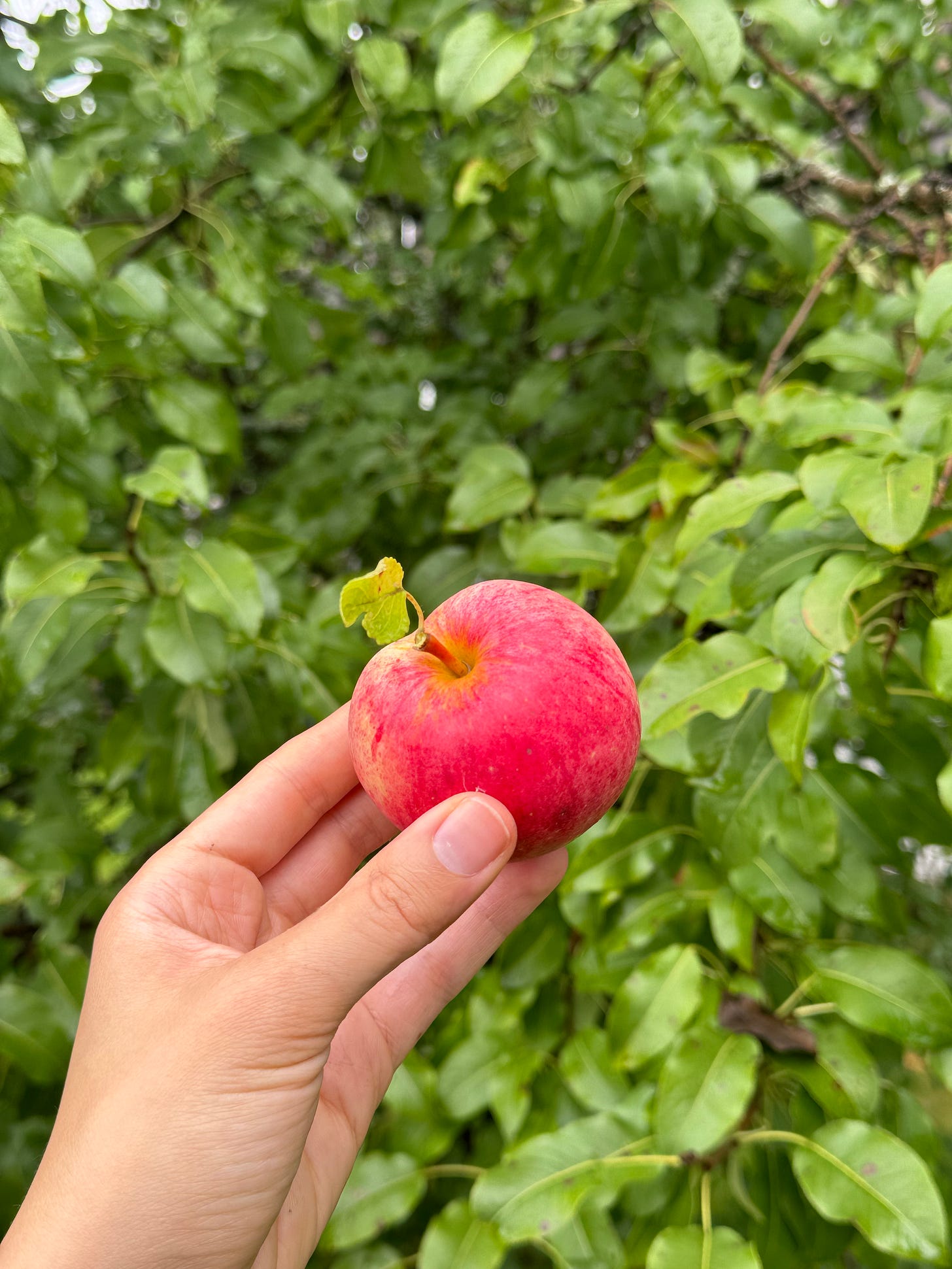👋+: Norwegian Apple Cake, Mushrooms Milanese & A Sweet Potato Ginger Loaf
two cakes and a feast + making chores cheerful
Allô! 👋
Welcome (back) to seasonal sundays, the supplement to good food at home where we take a closer peek at produce at its peak — with a short introduction, at least one recipe, and a (sometimes related) cooking Q&A. If you’d like to help the newsletter grow, feel free to hit the heart button above, or the share button below!
Happy Sunday! I hope you’re all well.
Like an early fall day that can’t quite decide whether to be warm or cold — sunny or wet — this issue of seasonal sundays contains within it a little bit of it all: apples, pears, almonds, oyster mushrooms, fennel, celery, sweet potatoes, pecans, ginger, and more.
If late summer has come to be known in your household as “Everything Season” (i.e. that time of year where so much fresh food is at its prime that it feels like everything is in season), I hope that, by the end of this newsletter issue, you’ll come to think of early autumn as “Everything Season Part 2”.
On today’s newsletter menu, we’ve got my version of Norwegian apple cake, a nationally beloved dessert to which I’ve added a not-untraditional twist of pears and almonds; “mushrooms milanese”, an autumnal spin on chicken cutlets that I like to serve not just with a fennel celery slaw, but also with a mountain of mash and a cascade of gravy (when in Scandinavia); and, last but not least, a soothing medley of sweet potatoes, pecans, and fresh ginger, which come together beautifully in a moist and warmly spiced sweet potato ginger loaf.
In addition, this week’s intro is all about storing autumn’s harvest for the long run, and, to finish, we’ve got a Q&A on taking the hassle out of housework.
There’s lots to choose from — and hopefully a little something for everyone! As always, I hope you’ll enjoy.
Wishing you a relaxing, cosy day and plenty of comforting meals ahead,
— Simone
This week, I thought it would be useful to focus a little on food storage. More specifically, how to store the ingredients featured in this newsletter so that you don’t end up with mushy apples or pears, fuzzy mushrooms, limp and slimy fennel or celery, wrinkled sweet potatoes, rancid almonds and pecans, or sad, shrivelled ginger.
This is, after all, harvest season — and it would be a great shame not to make it last.
STORING FOOD FOR WINTER
Much like how tomatoes are canned in abundance in the summertime, autumn is also a time where a lot of what is harvested needs to get preserved and stored in one way or another so that we can continue to enjoy that season’s produce all year long.
You don’t need to be a homesteader or have a big ol’ cellar in your home to store some food for winter (or, at least, into late fall). A few tweaks to the summertime modes of storage and a bit of awareness are all that’s needed, and the benefit is well worth the (minimal) effort: buying food in season and storing or preserving it for later is one of the cheapest and easiest ways to ensure that you’ll have access to quality produce for months to come.
As the temperatures drop, cold, dark spaces in your home — places like basements, garages, unheated pantries, draughty larders, or chilly mudrooms — can be especially useful for extending the amount of space you have for storing produce long-term. Even an insulated crate on a balcony or empty wine fridge can do the trick. Once late autumn and winter come around, storing long-lasting produce in these extra spaces becomes extra helpful, especially as it can free up valuable space in your usual refrigerator and cupboards.
Items like potatoes, onions, garlic, cabbages, and winter squashes will all keep perfectly well outside of the fridge, in a dark, well-aerated cold spaces (just keep them out of plastic so they can breathe). Other items like fennel and oyster mushrooms can only stay fresh for so long, so it’s good to know what will keep for days vs weeks vs months, and in what conditions.
A few that are good to know:
potatoes and sweet potatoes
Should be kept cool (not refrigerated), dark, and in relatively high (85-90%) humidity. Store away from ethylene-producing fruit and vegetables like apples and onions.
fennel and celery
Should be kept cold, leafy tops trimmed, tightly wrapped or placed in an airtight container to maintain moisture. (Many recommend wrapping celery in aluminum foil for this purpose). Both can also be frozen, though celery especially would benefit from being blanched first.
nuts
Should be kept somewhere cool and dark, ideally in their shells, sealed in an airtight container. For longer storage, keep in the refrigerator where the shelf-life is approximately six months, or in the freezer where their shelf-life is roughly one year.
onions, shallots and garlic
Should be kept cool (not refrigerated), dark, and in relatively low (65-75%) humidity. Store away from ethylene-sensitive fruit and vegetables like potatoes, carrots, and brassicas.
pears
For short-term storage, ripen at room temperature, then refrigerate in a resealable bag for a few weeks. For long-term storage, choose long-keeping varieties like Anjou, Bartlett, Bosc, and Comice, and store them in a cold, dark place with relatively high humidity. Ripen as needed, and preserve the pears when they begin to ripen after a few months (make pear sauce, freeze, or dry them into rings).
oyster mushrooms
Oyster mushrooms don’t keep for very long and don’t dry all that well, so you’ll want to keep them double-bagged in a rolled up paper bag that’s been popped into a partly closed plastic bag in the fridge (so they can breathe without drying out). If not using within 5 days, fry them up in fat then freeze.
ginger
Fresh ginger can keep refrigerated in a releasable bag for up to a couple of months (just make sure to remove of the air from the bag before sealing and re-sealing) or frozen — whole, sliced, or grated — for up to six months. It can also be pickled in vinegar and refrigerated, or dehydrated and ground, for even longer storage.
apples, part 1
To store apples so they’ll last a few weeks, keep them in a resealable container (like a plastic bag) in the fridge.
apples, part 2 (a deep dive for long-term storage)
To store apples so they last through winter, you’ll first want to pick the right varieties. Some are best eaten right away in fall (usually those that are sweeter, with thin skins), while others are best kept for a few months before using — usually these will have thicker skins and be more tart. Long-keeping varieties include McIntosh, Granny Smith, Braeburn, Golden Delicious, Fuji, Winesap, Honeycrisp, Northern Spy, Rome, and many more.
The next thing to consider is the condition of the apples: firm, unbruised, unblemished apples without cuts are best. Damaged apples will spoil faster and can cause others to rot as well (hence the phrase “one bad apple spoils the bunch”).
Once you’ve selected your apples for storage, the next things to consider are temperature and humidity: store your apples somewhere where the temperature ranges from 0-4°C, ideally where the air is neither too moist (they’ll rot) nor too dry (they’ll shrivel), about 90-95% humidity if you’re able to measure it.
Where you store your apples will be important in terms of what else is in the space too: apples release a ripening gas called ethylene, and should therefore not be stored next to ethylene-sensitive fruit and vegetables that you intend to store for a long time (these include potatoes and cabbages).
How you store your apples is important too. To prevent the spread or rot and maximise airflow in one go, you can wrap each apple individually in newspaper and layer them in vegetable crates lined with shredded paper.
Lastly, check your apples regularly! At least every week or two, check on your apples for any signs of mould or rot and remove any that threaten to spoil the rest of your stash.
Ultimately, storing autumn’s bounty is about watching over temperature, humidity, and those neighbouring ingredients — the quiet details that make all the difference. Many of autumn’s fruits and vegetables can sit contentedly for weeks, even months, outside the fridge, so long as they’re kept somewhere dark and cool, so try to make the most of any unheated spaces in your home as the temperatures drop. The principles I’ve detailed for long-term apple storage also extend beautifully to other produce too, so don’t hesitate to take some notes and take the plunge of long(er) term cold storage. After all, there’s a deep, reassuring pleasure in knowing that you’ve helped the season’s bounty linger, just a little while longer.
This week: two desserts and a meal to make the most of early autumn’s abundance and bounty! (You’ll find a PDF with concise versions of each recipe at the end of this section.)
norwegian apple cake 🇳🇴
Here in Norway, this is a cake that you’ll find at school events, dugnads, and community gatherings, as well as in most grandmothers’ recipe books. It’s one that nearly everybody grew up with — and for good reason. It’s simple to make, delicious, and solves a common problem of “too many apples”: indeed, in Norway, either you or someone you know is bound to have an apple tree, pear tree, plum tree, or cherry tree in their yard, or freely accessible in their neighbourhood (lots of local parks will have fruiting trees in them).
If someone is kind enough to share some of their apples (and pears) with you, baking them this cake is a wonderful way to say thank you.
A NORWEGIAN APPLE & PEAR CAKE (EPLEKAKE MED PÆRER)
makes 8-16 slices, depending on how large your slices are
EQUIPMENT YOU’LL NEED
Keep reading with a 7-day free trial
Subscribe to good food at home to keep reading this post and get 7 days of free access to the full post archives.












